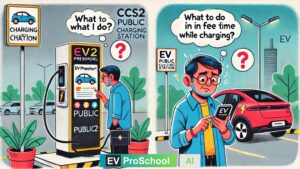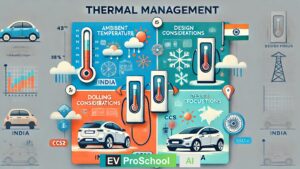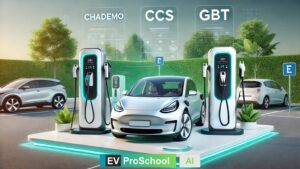As electric vehicles (EVs) become more popular, the need for a reliable and efficient charging infrastructure is crucial for widespread adoption. EV charging infrastructure encompasses different types of chargers, from AC chargers to high-speed DC chargers, and includes options for both home and public use. Understanding the charging options, power requirements, and charging times helps EV owners make the most of their vehicles, maximizing convenience and efficiency. Let’s take a closer look at the types of EV chargers available, the differences between home and public charging solutions, and the factors that influence charging times.
Types of EV Chargers: AC and DC Fast Charging
EV chargers are typically divided into two categories based on the type of current they use: AC (alternating current) and DC (direct current) charging. Each type has distinct characteristics and advantages, catering to different charging needs.
1. AC Charging (Level 1 and Level 2)
AC chargers are commonly used for both home and public charging. These chargers convert the AC electricity from the grid into DC electricity within the EV using an onboard charger.
- Level 1 Charging: Level 1 chargers use a standard 120V household outlet and offer charging rates of around 2-5 miles of range per hour. This slower charging option is often used as an emergency backup or for overnight charging, as it can take 24 hours or more to fully charge a typical EV battery.
- Level 2 Charging: Level 2 chargers are more powerful, providing 240V and delivering charging rates of around 10-30 miles of range per hour. Level 2 chargers are ideal for home and workplace use, as they can fully charge an EV battery within 4-8 hours. Many public charging stations also offer Level 2 charging.
2. DC Fast Charging (Level 3)
DC fast charging bypasses the vehicle’s onboard charger, delivering DC power directly to the battery at a much faster rate. These chargers operate at higher power levels, often between 50 kW and 350 kW, and can add substantial range in a short time, making them ideal for long-distance travel and quick recharges.
- Fast Charging Speed: DC fast chargers can add up to 80% charge within 15-30 minutes, depending on the charger power level and the battery’s capacity.
- Availability: These chargers are typically found at public charging stations, especially along highways and in urban centers where EV owners may need quick top-ups.
Home vs. Public Charging Solutions
Charging an EV can be done at home or at public stations, each offering unique advantages based on convenience, cost, and charging speed.
Home Charging
Home charging is one of the most convenient options for EV owners, allowing them to charge their vehicles overnight or during off-peak hours.
- Installation Options: Home charging can be done with either Level 1 (standard outlet) or Level 2 (240V outlet) chargers. Level 2 chargers require a dedicated circuit and professional installation but offer significantly faster charging times.
- Cost Savings: Home charging can be more cost-effective than public charging, especially when taking advantage of lower electricity rates during off-peak hours. Many EV owners find that charging at home meets most of their daily driving needs.
- Independence: Home charging provides the flexibility of charging the vehicle at any time, making it easy to start each day with a full charge.
Public Charging
Public charging stations provide more options for EV drivers on the road or for those without access to home charging.
- Types of Public Chargers: Public charging stations can offer Level 2 or DC fast charging. Many retail locations, workplaces, and dedicated EV charging networks provide access to public chargers.
- Accessibility: Public charging is ideal for EV drivers who live in apartments or do not have dedicated parking spots with home charging capabilities. It also serves as an essential option for long-distance travel.
- Charging Networks and Payment Options: Public chargers often belong to charging networks like Tesla Superchargers, ChargePoint, and EVgo. Payment options can vary, including pay-per-use, subscriptions, and free charging at select locations.
Charging Times and Power Requirements
Charging time and power requirements depend on several factors, including the type of charger, the EV’s battery capacity, and the level of charge needed.
Factors Affecting Charging Times
- Battery Capacity: Larger batteries take longer to charge, especially with slower charging methods. For example, a 100 kWh battery will take twice as long to charge as a 50 kWh battery on the same charger.
- State of Charge (SOC): Charging time is faster when the battery is less full. For example, DC fast chargers typically charge an EV up to 80% very quickly, after which the charging rate slows down to protect battery health.
- Charger Power Output: Higher-power chargers deliver energy more quickly. For example, a Level 1 charger providing 1.5 kW will take longer than a Level 2 charger providing 7.2 kW. DC fast chargers can provide anywhere from 50 kW to 350 kW, drastically reducing charging time.
- Vehicle Compatibility: Not all EVs can handle high-power charging, so the charging speed will be limited by either the vehicle’s maximum charging capacity or the charger’s power output, whichever is lower.
Power Requirements
The power requirements of an EV charging system vary depending on the type of charger and usage patterns.
- Level 1 Charging: Level 1 chargers use standard 120V household outlets and draw around 1.4 kW of power. They are suitable for slow, overnight charging but may not be practical for those with higher daily mileage needs.
- Level 2 Charging: Level 2 chargers use 240V power, similar to household appliances like dryers, and deliver between 7-22 kW of power. They require a dedicated circuit and professional installation but are ideal for faster home or workplace charging.
- DC Fast Charging: DC fast chargers typically use 400V or higher, delivering 50-350 kW. These chargers are designed for high-power, short-duration charging sessions and require robust infrastructure to handle the higher power demands.
Future Trends in EV Charging Infrastructure
As EV adoption grows, advancements in charging infrastructure continue to make EV charging faster, more convenient, and more accessible.
- Ultra-Fast Charging Networks: Many charging networks are expanding their ultra-fast charger offerings, capable of delivering 150 kW or more, which can charge EVs in 10-20 minutes. This trend aims to make EVs more practical for long-distance travel and reduce waiting times at charging stations.
- Wireless Charging: Research is underway to develop wireless, inductive charging, which could eliminate the need for plugging in entirely. Wireless charging could be integrated into parking spaces or roadways, allowing EVs to charge automatically when parked or even while driving.
- Vehicle-to-Grid (V2G) Technology: V2G technology enables EVs to send electricity back to the grid, helping balance demand and potentially providing cost savings for EV owners. This bidirectional charging capability is becoming more feasible with advancements in AC-DC converter technology.
Conclusion
The EV charging infrastructure is a cornerstone of the electric mobility revolution, providing the means to keep EVs powered up and ready to go. With options for AC and DC fast charging, home and public charging solutions, and continuous improvements in charging times and power efficiency, EV charging has become more accessible and efficient than ever. As technology continues to advance, EV drivers can look forward to even faster, more convenient, and eco-friendly charging options that make electric mobility a viable choice for everyone.


